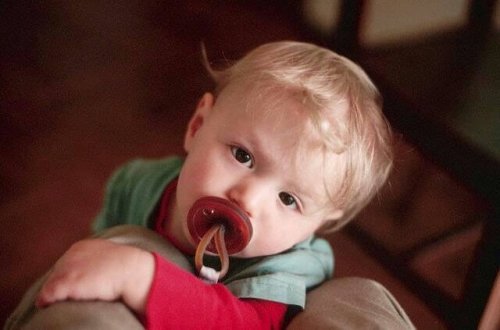Funny Quirks That Babies Have

Each child, with their own personality and ways of expressing themself, fills our lives with joy. Some of them have funny quirks, which surprise us and make us laugh.
In this article, we’ll present you with some of the funny quirks that children of all ages have. Does your little one have any?

Funny quirks that children have
Funny bottle-feeding habits
Baby bottles are one of the implements that produce the funniest quirks, perhaps because babies get bored during the whole time they’re lying in bed or in their mother’s arms while drinking milk. Below, we’ll share some of our favorites in this regard.
While drinking their bottles, many little ones like to do the following:
- Making curls in the mother’s hair by twirling it around their index finger.
- Stroking their mother’s ear or stroking their own ear.
- Running their feet through their mother’s hair.
- Kneading the inside of their mother’s arm, almost reaching the armpits, as if it were bread dough. This part of the body is very soft, which is why many little ones love to touch it.
- Caressing their mother’s hands and fingers with their own. Sometimes this caressing entails squeezing their mom’s fingers or pulling very hard on them as if they wanted to tear them off.
- Letting you kiss their feet and hands. If they’re on their mother’s lap, they love to be kissed under their toes. They put one foot up to their mother’s mouth, then the other, and so on. Then they follow with one little hand, the other, and back to the feet.
- Touching their mother’s face and going over, in detail, each of her features. They touch her lips, nose, eyes, want to touch inside her eyes, etc.
- Using their index and middle fingers like a fork and insistently sticking them into their mother’s mouth and nose.

Sleeping quirks
In addition to bottle-feeding, there are also the many funny quirks that children tend to develop regarding bedtime. In fact, these are the things that allow them to fall asleep. Without them, many children wouldn’t even begin to close their eyes.
In order to fall asleep, many children like:
- Being rocked and sung to until they fall soundly asleep.
- Being put in their bed or cradle and having you pat them on the buttocks until they fall completely asleep.
- Sucking their thumb.
- Having their tummy stroked.
- Sleeping on the same side of the bed or crib (as do adults).
- Having a fan held over their face, whether or not there’s air conditioning in their room.
- Stretch out the sheet they’re sleeping on top of over and over again. The bedding may not have any wrinkles, but children like everything to be perfect.
- Sleeping with the same doll or pillow every night.
- Sucking on their big toe.

Funny quirks having to do with pacifiers
Pacifiers are another instrument that infants get crazy with.
Many infants like to hide pacifiers in various places and find them to suck on for a little while and then put them back in the same place.
Also, some babies suck on their pacifiers in an unusual way. For example, they put it on one side of their mouth and chew it that way. Then they change it to the other side and do the same thing. Some babies even suck on two pacifiers at once, or keep one in their mouth and another in their hand.
There are also cases of little ones who don’t suck their pacifier at all but walk around with it wherever they go. They want to show off and no one can take it away, but they never put it in their mouth.
Each child, with their own personality and ways of expressing themself, fills our lives with joy. Some of them have funny quirks, which surprise us and make us laugh.
In this article, we’ll present you with some of the funny quirks that children of all ages have. Does your little one have any?

Funny quirks that children have
Funny bottle-feeding habits
Baby bottles are one of the implements that produce the funniest quirks, perhaps because babies get bored during the whole time they’re lying in bed or in their mother’s arms while drinking milk. Below, we’ll share some of our favorites in this regard.
While drinking their bottles, many little ones like to do the following:
- Making curls in the mother’s hair by twirling it around their index finger.
- Stroking their mother’s ear or stroking their own ear.
- Running their feet through their mother’s hair.
- Kneading the inside of their mother’s arm, almost reaching the armpits, as if it were bread dough. This part of the body is very soft, which is why many little ones love to touch it.
- Caressing their mother’s hands and fingers with their own. Sometimes this caressing entails squeezing their mom’s fingers or pulling very hard on them as if they wanted to tear them off.
- Letting you kiss their feet and hands. If they’re on their mother’s lap, they love to be kissed under their toes. They put one foot up to their mother’s mouth, then the other, and so on. Then they follow with one little hand, the other, and back to the feet.
- Touching their mother’s face and going over, in detail, each of her features. They touch her lips, nose, eyes, want to touch inside her eyes, etc.
- Using their index and middle fingers like a fork and insistently sticking them into their mother’s mouth and nose.

Sleeping quirks
In addition to bottle-feeding, there are also the many funny quirks that children tend to develop regarding bedtime. In fact, these are the things that allow them to fall asleep. Without them, many children wouldn’t even begin to close their eyes.
In order to fall asleep, many children like:
- Being rocked and sung to until they fall soundly asleep.
- Being put in their bed or cradle and having you pat them on the buttocks until they fall completely asleep.
- Sucking their thumb.
- Having their tummy stroked.
- Sleeping on the same side of the bed or crib (as do adults).
- Having a fan held over their face, whether or not there’s air conditioning in their room.
- Stretch out the sheet they’re sleeping on top of over and over again. The bedding may not have any wrinkles, but children like everything to be perfect.
- Sleeping with the same doll or pillow every night.
- Sucking on their big toe.

Funny quirks having to do with pacifiers
Pacifiers are another instrument that infants get crazy with.
Many infants like to hide pacifiers in various places and find them to suck on for a little while and then put them back in the same place.
Also, some babies suck on their pacifiers in an unusual way. For example, they put it on one side of their mouth and chew it that way. Then they change it to the other side and do the same thing. Some babies even suck on two pacifiers at once, or keep one in their mouth and another in their hand.
There are also cases of little ones who don’t suck their pacifier at all but walk around with it wherever they go. They want to show off and no one can take it away, but they never put it in their mouth.
All cited sources were thoroughly reviewed by our team to ensure their quality, reliability, currency, and validity. The bibliography of this article was considered reliable and of academic or scientific accuracy.
- Winnicott, D. W. (1967). Objetos y fenómenos transicionales : Un estudio sobre la primera posesión no Yo. Recuperado de https://www.pep-web.org/document.php?id=revapa.024.0817a
- Wolf, A. W., & Lozoff, B. (1989). Object attachment, thumbsucking, and the passage to sleep. Journal of the American Academy of Child & Adolescent Psychiatry, 28(2), 287-292.
This text is provided for informational purposes only and does not replace consultation with a professional. If in doubt, consult your specialist.








